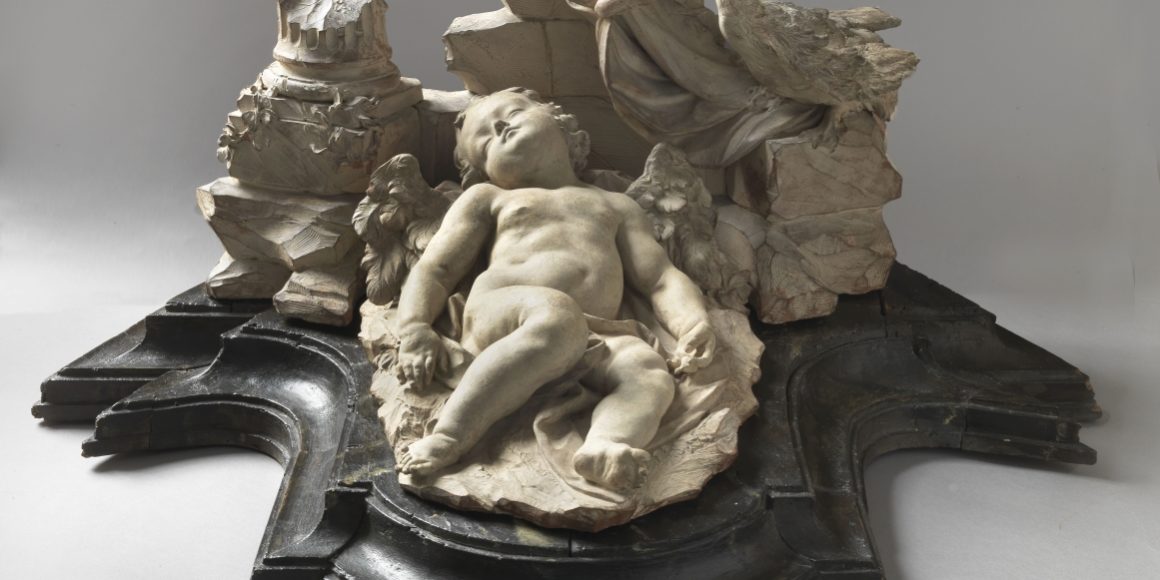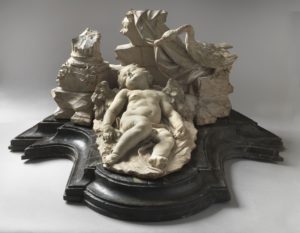| NOT AVAILABLE

(Pescia 1686 – Rome 1754)
Apollo in the Guise of a Swan Awakening Eros from Sleep;
1714-27 ca.;
terracotta with slipware (ingobbiatura),
cm 32 x 68 x 51
The terracotta model discussed here was interpreted by Stella Rudolph in 2007 (written communication of 20 October 2007) as a Sleeping Eros and attributed to the sculptor Pierre le Gros Le Jeune (Paris 1666 – Rome 1719); the scholar, in noting the singularity of the iconographic theme, suggested a link with Arcadian circles, conjecturing that it was commissioned by the Pistoian literary figure Niccolò Forteguerri. The latter was substantiated, in her view, by the provenance of the terracotta from Palazzo Forteguerri in Pistoia, where the sculpture, however, is documented only at the end of the 19th century.
In our opinion, however, a more appropriate attribution would be to the sculptor Agostino Cornacchini (Pescia 1686 – Rome 1754); the subject can also be more adequately explained as Apollo in the guise of a swan awakening Eros from sleep, or the primacy of Poetry over Eros.
The plastic composition, set on the original ebony-coloured soft-wood base, consists of two elements: the figure of the sleeping Cupid, lying gently on the ground on wings with soft plumped feathers, and the semicircular architectural background against which the swan is posed. The background presents a blend of natural elements (rocks and caper plants) and architectural elements combined to evoke the ancient world. On the left stands a fragment of a ruined column with Attic base, while in the centre some uniform blocks, also apparently broken and chipped, form the ideal scenario for the bird seeking with its beak to lift the drapery abandoned on the masonry. The quality of the clay, of a decided red, and the marble-coloured patina, make the two pieces cohere.
While Rudolph believed that the action of the unveiling by the swan (emblem of Venus, mother of Cupid), had to imply that sleeping Love can be awakened, an alternative reading of the sculptural group can be proposed. The hyperborean bird is sacred not only to Venus but also to Apollo, god of the Sun and of the arts consecrated on Mount Parnassus, where according to the ancients he resided together with the nine Muses. The swan could therefore symbolize Apollo, rather than Venus, and establish the primacy of Poetry which, through the power of words, succeeds in awakening dormant Eros, in a complex allegorical artifice dear to Arcadian circles in which the exercise of poetry served to evoke the idyllic and bucolic dream.
A native of Pescia, Agostino Cornacchini was a pupil of Giovanni Battista Foggini in Florence, the sculptor and court architect in the service of Cosimo III dei Medici (for an updated biographical note on Cornacchini, cf. J. Montagu in Art in Rome 2000, p. 251). During this period of apprenticeship in the grand-ducal capital, the young Agostino entered the graces of the Florentine scholar and collector Francesco Maria Niccolò Gabburri (1676-1742), of whom he became a protégé. It was Gabburri who took the artist to Rome in 1712 and introduced him into the entourage of his uncle, the powerful Pistoian cardinal, Carlo Agostino Fabroni (1651-1727).
Elevated to the purple by Clement XI Albani in 1706, Fabroni chose as his Roman residence the palace of the Marquis Francesco Maria Ruspoli all’Aracoeli, at the time available for rent, and lived there up to his death in 1727. Fabroni’s residence soon became a prominent cultural salon in the of Rome of Clement XI, regularly hosting antiquarians, scholars and artists (on the artistic commissions of Cardinal Fabroni, see Cola 2011). From 1714 to 1720 Agostino Cornacchini himself was guest in the Fabroni residence, and maintained affectionate and professional bonds with the cardinal even after leaving his home; indeed, it was to Cornacchini that the cardinal entrusted the execution of his funeral monument in Sant’Agostino (now vanished). It was probably in Rome between 1714 and 1716 that the two marble groups were made, one depicting the Nativity and the other the Deposition from the Cross, that the cardinal bequeathed, along with books and manuscripts, to his home town, and are now held by the Biblioteca Fabroniana. The two sculptures, although made by Cornacchini at an early stage of his career, are fine expressions of a language that blends the teachings of his Tuscan master, Giovanni Battista Foggini, with milder and softer tones that, especially in the scene of the Nativity, achieve moments of formal exquisiteness, as can be seen in the gentle beauty of the Virgin’s face (for the Nativity group, fig. 1, cf. R. Spinelli in Il fato e la ragione 2009, pp.106-107, cat. 22).
The Victoria and Albert Museum of London holds the terracotta model of the latter group which well demonstrates Cornacchini’s skill in creating figures in the round (fig. 2), revealing a very characteristic treatment of surface through ample use of a toothed spatula to create streaks on the clothing simulating fabrics rippled and worn by continuous movement. The same technique is found in the group under discussion, especially to characterize the rocky surfaces in the intent of recreating their unfixed and changing look; moreover, it should be noted that the delicate woven wicker basket that serves as a cradle for the Child bears a close resemblance to the wings of the sleeping Cupid, whose feathers are modelled with almost calligraphic skill.
In addition to the monumental sculptures for which he is perhaps best known, the sculptor’s production regularly featured small-format groups, in exquisitely Arcadian taste, which gave an optimal rendering of those characteristics of grace and exactitude in execution so appreciated by contemporary patrons and in particular by Francesco Maria Niccolò Gabburri, who owned a bronze Sleeping Endymion and its terracotta model – identified as that of the Museum of Fine Arts of Boston (fig 3).
The delicate modelling of Endymion’s head and flesh, the details of his cloak and of the foliage exemplify the freshness and immediacy of the sculptor’s touch, as does the small dog at the shepherd’s feet, the naturalistic rendering of which is found with the same descriptive intent also in the allegorical swan in the group under discussion. To this should be added the predilection for compositions that avoid perfect symmetry, in which the play of balance is judiciously disjointed so as to create fluid but harmonic compositions, as in the case of our terracotta and, for example, the model of Judith with the Head of Holofernes, today in a private collection (D. Lauri, in La fabbrica della bellezza 2017, pp. 134-135, cat. 10). That work derives from the commission of Anna Maria Luisa dei Medici of twelve bronze groups of Biblical episodes, made by nine noted Florentine sculptors of the early eighteenth century. The terracotta with Giuditta and the subsequent bronze casting (Birmingham, Museum and Art Gallery) were done by Cornacchini to Rome in 1722 and the success of this composition is confirmed by a later porcelain version made by Gaspero Bruschi for the Manifattura Ginori between 1746 and 1750 (Los Angeles, County Museum of Art). The billows in the robe of Judith that stress the bending of the right knee with ample concentric undulations are clearly visible in the terracotta piece under discussion here, which in the drapery lifted by the swan presents an analogous and almost matching pattern. The graphic and linear cut of these folds can be considered a typical feature of Cornacchini’s formal grammar as he invariably returned to it in such small-format works as those mentioned above but also in sculptures of a more monumental nature as in the figure of Speranza carved in white marble in 1724 for one of the niches of the Monte di Pietà chapel in Rome.
According to the data in our possession and the stylistic matches presented, one may conclude that this work must have been executed by Agostino Cornacchini in Rome in the interval between his arrival in the city and about 1727, the year of the death of Cardinal Fabroni, a period in which the artist’s ties with Tuscany were still very strong and could well explain the Pistoia provenance of the group in question. Since in his works the French sculptor Pierre Le Gros (1666-1719) maintained a strong compositional link with the high Baroque of the Algardi mould, offering compositions in which the pictorialism and decorative aspects never overstep the plasticity and centrality of the figures, the previous conjectured attribution to him must be rejected.
Adriano Amendola
Cristiano Giometti
Art in Rome 2000
Art in Rome in the Eighteenth Century, catalogue of the Philadelphia and Houston exhibition (Philadelphia Museum of Art, March 16-May 28, 2000; The Museum of Fine Arts, June 25-September 17, 2000), edited by E. Peters Bowron, J.J. Rishel, London 2000.
Cola 2011
M.C. Cola, ‘Dipinti e sculture nel palazzo romano del cardinale Carlo Agostino Fabroni (1707-1727)’, in ‘Palazzi, chiese, arredi e scultura’, edited by Elisa Debenedetti, Studi sul Settecento romano, 27, Rome 2011, pp. 81-95.
Il fato e la ragione 2009
Il fato e la ragione. Arte del Settecento a Firenze, catalogue of the Florence exhibition (Galleria degli Uffizi, 30 maggio-30 settembre 2009), edited by C. Sisi, R. Spinelli, Florence 2009.
La fabbrica della bellezza
D. Lauri in La fabbrica della bellezza. La manifattura Ginori e il suo popolo di statue, catalogue of the Florence exhibition (Museo Nazionale del Bargello, 18 maggio-1 ottobre 2017), edited by T. Montanari e D. Zikos, with the collaboration of C. Giometti and M. Marini, Florence 2017.
The Carlo Virgilio & C. Gallery searches for works by Cornacchini Agostino (1686-1754)
To buy or sell works by Cornacchini Agostino (1686-1754) or to request free estimates and evaluations
mail info@carlovirgilio.co.uk
whatsapp +39 3382427650
